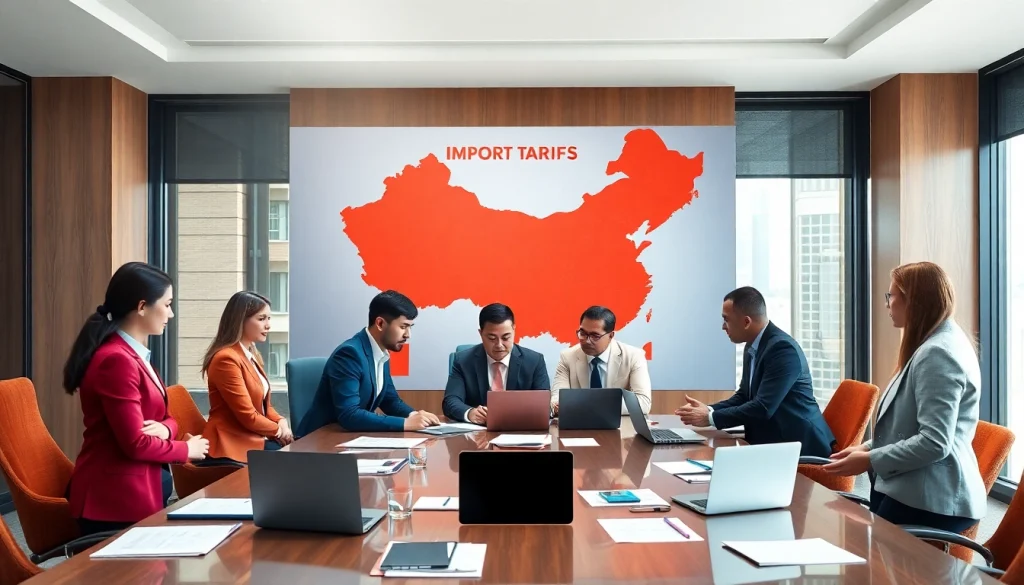
Overview of Import Tariffs in China
Import tariffs are critical components of global trade, affecting the flow of goods and services across borders. Particularly, understanding import tariffs china is imperative for businesses engaged in international trade and economics analysts alike. They play a pivotal role in shaping economic relationships between countries, especially between the U.S. and China, two of the world’s largest economies.
What Are Import Tariffs?
Import tariffs are taxes imposed by a government on goods and services imported from other countries. The primary purpose of these tariffs is to raise revenue for the government and protect domestic industries from foreign competition. Foreign companies can incur additional costs when selling their products in a country due to these tariffs, which can influence pricing, competition, and market dynamics.
Key Players in Tariff Implementation
Various entities are involved in the implementation of import tariffs, including:
- Government Agencies: Agencies such as the U.S. Customs and Border Protection (CBP) and the Chinese General Administration of Customs enforce tariff regulations, collect duties, and facilitate trade compliance.
- International Organizations: Bodies like the World Trade Organization (WTO) set forth guidelines and agreements that govern tariff rates and trade practices, aiming to maintain fair trade across nations.
- Importers and Exporters: Businesses engaged in international trade must navigate the complexities of tariff implications, ensuring compliance while optimizing costs related to tariffs.
Historical Context and Recent Changes
The landscape of import tariffs between China and the U.S. has undergone significant transformations over recent years, particularly amid rising tensions and trade negotiations. In recent times, the U.S. government has adjusted tariff levels from as high as 145% during trade disputes under the Trump administration to more stabilized percentages now, with targeted tariffs impacting specific sectors such as technology and agriculture. These ongoing changes reflect strategic economic policies and the shifting dynamics of global trade.
Impacts of Import Tariffs on U.S.-China Trade Relations
Current Tariff Rates and Their Implications
As of now, the overall tariffs on Chinese imports can reach up to 55%, according to recent policies. This broad implementation affects various sectors, including manufacturing and technology, forcing companies to reconsider their sourcing strategies. These tariffs have significantly increased costs for U.S. businesses relying on Chinese products, consequently affecting consumer prices and the competitive landscape.
Effects on Exporters and Importers
The economic repercussions of import tariffs are profoundly felt by both American importers and Chinese exporters. U.S. importers confront higher costs that may lead them to raise prices, potentially reducing demand. Conversely, Chinese exporters face challenges in maintaining competitiveness in the U.S. market due to increased taxation on their goods. As companies navigate these tariffs, many are seeking ways to adjust their supply chains, sourcing from alternative countries to bypass these added costs.
Future Projections and Trends
Looking ahead, the impact of current tariffs will likely spur further discussions around trade policy. Analysts speculate that decreasing tariffs to levels more conducive to mutual benefit could foster renewed economic cooperation. However, it will require substantial negotiations. Future trends may also reveal an increase in global trade partnerships that aim to balance competitive advantages and mitigate the adverse effects of tariffs.
Navigating Compliance with Import Tariffs
Essential Documentation for Tariff Management
Effective management of import tariffs requires comprehensive documentation. Importers must be prepared to provide documents such as:
- Commercial Invoices: Detailed accounts of goods being imported, indicating value and description.
- Bill of Lading: Instructions for shipment, essential for customs clearance.
- Tariff Classification: Accurate classification of products under HS codes to ensure correct tariff applications.
- Certificates of Origin: Verifying where the goods are produced, which can influence tariff rates based on trade agreements.
Strategies for Reducing Tariff Costs
To mitigate tariff costs, businesses can consider several strategies:
- Sourcing Alternatives: Identifying suppliers from countries with lower or no tariffs can reduce costs significantly.
- Tariff Engineering: Re-designing products to fit different classifications that may be less heavily taxed.
- Utilizing Free Trade Agreements: Leveraging existing agreements that may provide lower tariffs or tax exemptions.
Common Compliance Challenges
Despite the strategies available, businesses often face compliance challenges such as:
- Complex Regulations: Tariff laws and regulations can be intricate and ever-changing, making it difficult to keep up.
- Misclassification Risks: Incorrectly classifying goods can lead to fines or increased tariffs.
- Documentation Errors: Incomplete or inaccurate paperwork can cause delays and additional costs.
Economic Impact of Import Tariffs on Businesses
Cost Analysis: Import Tariffs vs. Domestic Production
The decision between importing goods and manufacturing domestically hinges significantly on the associated tariffs. By conducting a thorough cost analysis, businesses can determine whether the additional expenses incurred through tariffs outweigh the benefits of importing. This analysis often encompasses labor costs, production efficiency, and supply chain logistics.
Case Studies: Businesses Adapting to Current Tariffs
Several businesses have found innovative solutions to adapt to the changing tariff landscape. For instance, one major electronics manufacturer shifted a portion of its supply chain from China to Vietnam to avoid tariffs. These strategic decisions highlight a growing trend where companies proactively respond to tariffs by optimizing their production locations.
Market Response to Tariff Changes
The market’s response to changing tariffs can be dramatic. Tariff fluctuations often lead to volatility in stock prices as investors react to potential earnings impacts. Companies that successfully navigate these changes often emerge as leaders in their respective markets, while those unable to adapt may experience downturns or even closures.
Resources for Understanding and Managing Import Tariffs
Government Agencies and Their Roles
Various government agencies play crucial roles in the oversight and management of import tariffs:
- U.S. Customs and Border Protection (CBP): Responsible for enforcing tariffs, collecting duties, and facilitating safe and efficient trade.
- Department of Commerce: Provides resources and support to businesses navigating international trade, including evolving tariff policies.
- World Trade Organization (WTO): Provides a global platform for discussing trade negotiations and the implementation of international trade laws.
Webinars and Training for Businesses
Many organizations offer training programs and webinars focusing on navigating import tariffs effectively. These educational resources provide valuable insights into compliance requirements, strategic cost management, and adapting to a changing trade environment. Companies are encouraged to invest in these opportunities to ensure that their teams remain informed and competent.
Online Tools for Tariff Calculations
With evolving tariff structures, online tools can assist businesses in accurately calculating import duties and understanding potential costs associated with their trade partnerships. Utilizing these tools can lead to more informed business decisions and improved financial forecasting based on current tariff rates.






